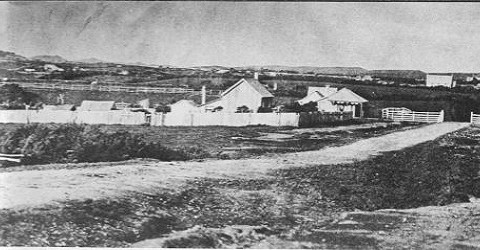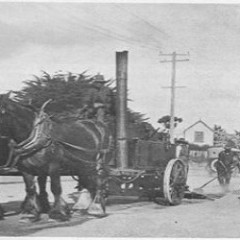6:6
made her first visit to Port Taranaki. Her emblem is one of many from ships which adorn the walls of the city council chambers.
World War One stimulated the country's interest in flying. And in November, 1920, when it was announced a Walsh Bros Avro Moth would visit New Plymouth on a demonstration flight, the racecourse was thronged with sightseers. For two days joyrides were highly popular at $5 a flight, and one of the first passengers was the town clerk, R. Day. On the 17th flight the aeroplane, carrying Mayor James Clark and Miss Kathleen Warnock, and piloted by Richard Russell, crashed, killing all three. This was the first aeroplane seen in New Plymouth, but the tragedy did not dampen enthusiasm. By 1928 an aero club had been formed at the instigation of the New Plymouth Tourist and Expansion League. 1. S. Connett, of Bell Block, offered free use of his farm for five years, and by 1930 flying had caught the imagination of a moderately well-to-do section of young people. In 1933 the council bought 47 ha of the Connett Estate surrounding the land, then owned by the New Plymouth Aero Club, and in spite of the depression development of the aerodrome proceeded. C. Melton Patchett, in a paper presented on the occasion of the Ministry of Works centenary in 1971, recalled that the ministry did most of the development work: 'Aerodromes were first built more or less by patching up a bit of a farm paddock as was done on Connett's farm. Following the successful use of this farm as a flying field, an Airport Board (the first in New Zealand) was established at the instigation ofMr Bellringer, the most youthful-minded Town Clerk of New Plymouth. The work was done by a team of about 240 unemployed men with long-handled shovels, hand-sharpened spades, wheelbarrows and sometimes boards to wheel them on when the mud became too deep. The men got two days a week work at a dollar a day and after three years the airport was completed. Patchett took over the extension work in 1936 and had about 120 men working for him. 'I had some pretty uproarious times with the men-they had strikes, we had the politicians out, we had an ex-MP, the potential MP and the existing MP, all competing for the men's votes because it was thought an election was coming up. We had an inspecting engineer down on one occasion from Wellington and the usual thing- the men got their price and a month later 1 got a request from, the Under-Secretary to explain why such high wages were being paid.' Before the airport was completed there was a gala occasion when 15,000 people welcomed the Southern Cross, piloted by Kingsford- Smith as he landed from a direct flight from Australia in 1934.
The official opening of the Bell Block was another gala occasion, with more than 30 aircraft giving flying and static demonstrations. When, on June 26, 1937 the inaugural flight of the Union Airways aeroplane the Lockheed Electra, Kuaka, landed on its way from Auckland to Wellington, passengers for Palmerston North included the Mayor, E. R. C. Gilmour, and the New Plymouth MP, S. G. Smith. With their tickets they were given a packet containing cotton wool and chewing gum. Lockheed Electras continued to call at New Plymouth until the outbreak of war, when the Government took over the airfield and developed it into one of the largest RNZAF flying and navigational schools in the country, using more than 25 aircraft and housing up to 600 Air Force personnel. The grassed field rapidly became inadequate for increased landing weights of post-war civil aircraft and the local authorities of Taranaki formed ajoint committee to investigate replacing the grass runways with a hard surface. It was found the underlay of old peat swamp about 3 m below the surface of the brown ash made any surfacing capable of only medium-loading capacity, so the present Brown Road site was bought. In 1962 the cost of the new airport was estimated at $1,300,000; by the time it was opened on November 7, 1966, the bill was more than $2 million.
Ten years after Union Airways, with their Dominie and Electra aeroplanes, first used the Bell Block Airfield, the National Airways Corporation (now Air New Zealand) began services with Lodestars, as well as Douglas DC3s which had earned a world-wide reputation for reliability and performance in war.
Converted to civilian use, it was an ideal aeroplane for grass runways. With the use of the new airport jet-prop Fokker Friendships were introduced. Some idea of the growth of air traffic to and from New Plymouth can be gained from statistics: In 1959 30,496 passengers were handled; 20 years later in 1979 the annual figure was 102,664. When the Brown Road airfield became operational in 1966 the aero club transferred its activities to the new venue. It caters for private and charter flying and air ambulance work, and since its formation has always been active in flying training. Its membership has grown from a handful in 1928 to more than 250, and its fleet from one Gipsy Moth to eight Cessna aircraft. One hundred and thirty-one club members served in World War Two, of whom 35 were killed. Among early enthusiasts of the club were the Pepperell and Derby families. They had something in common other than aviation: they both lived, for a time, in one of the town's oldest and most unusual houses-the Square and Round House. This building was made in England for the Hirst family and brought, in bundles, in the sailing ship Gwalior in 1852, from which it was floated ashore through the surf. The Round House part was in fact octagonal in shape, with a central chimney and triangular bedrooms in the upper storey. It was attached by a single storey link to the Square House. Erected in Devon Street, it served many purposes during its 87-year lifespan-as a family home, and during the land wars, a military conference headquarters.
In 1905 it was moved to the back of its Devon Street site, to face Courtenay Street opposite the Plunket Rooms, where it remained until demolished in 1938. Among its most distinguished occupants was Miss Jean Batten who spent several of her childhood years there>' before embarking on a career in aviation which brought her world fame. On the final leg of her flight from England to New Zealand in a Percival Gull aeroplane in 1936, she took off from Richmond RAAF Base near Sydney. The Derby family and other members of the New Plymouth Aero Club had tried to persuade her to visit the aerodrome. She did, in fact, make New Plymouth her landfall and flew low over the town. On reaching the Bell Block airfield she dipped in salute to the many enthusiasts waiting for her to land. But her scheduled terminal was Auckland where a much larger crowd awaited her, and she flew on, the first woman to fly the Tasman Sea solo. Other air services also use the airport.
Rural Air Services (formerly Rural Aviation) operated out of New Plymouth for 30 years. Formed in 194925 it was one of the country's earliest aerial topdressing firms. Among its first assets were two Tiger Moth aircraft bought from the aero club, which were modified in the firm's Bell Block workshops. Each was fitted with specially designed steel hoppers, and following trials the manager and the founder of the firm, Miles King, reported: 'From touchdown to takeoff the loading operation was accomplished within a minute and the distribution of the load was completed in about eight seconds.' Shortly afterwards, King, embarking on his first contract in the hilly Awakino area, sustained the firm's first crash: the wing of his Tiger Moth touched a fence and slewed round into a fence, causing damage estimated at $400. Apart from some bruises he was uninjured. In spite of this setback the business prospered and by 1967 it was using more than 21 aeroplanes, employing a staff of 85, and operating from several aerodromes and landing strips in various parts of New Zealand. King was also the founder of Rex Aviation, based in New Plymouth, which concentrated on aircraft sales in New Zealand, Australia and the Pacific Islands. King and Philip Lightband, Rural Aviation's general manager, made the first trans-Pacific flight in light aircraft when they flew two Cessna 310's from Wichita in the US to New Zealand. In the 1970s a new shape was seen-and heard--over the city: helicopters of varying sizes ferrying personnel, and equipment to the oil rigs and the Maui platform offshore.


